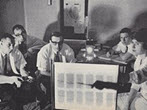The Physician Assistant Profession: Reflections on Its Past, Present, and Future
The physician assistant (PA) profession emerged in the 1960s, marking the beginning of what was initially a bold but modest experiment in medical education and health care delivery. Today the profession represents a major innovation in the training of health care professionals and the provision of patient care. The “Reflections” in this module have been developed for helping undergraduate and graduate students appreciate and understand the PA profession as a 20th century social innovation.
Using online primary source materials, biographies, oral histories, and reading assignments, students will explore the origins, professional development, and integration of PAs into all aspects of heath care both nationally and internationally. They will examine the complex social, economic, and political changes that took place in post-World War II America, leading to the creation of this new health profession in the 1960s and 1970s. Students will trace the past and any future changes regarding “who, where, and how” health care is delivered. They will discover how PAs work interdependently with physicians and other health care professionals, both adapting to and brining about social changes in order to meet the people’s ever growing needs for health care. Students will consider PAs as active partners in developing a collaborative health care model that provides accessible, affordable and high-quality health care services in the United States and other countries.
Henry B. Perry, MD, PhD, MPH, authored this module in collaboration with several other health care professionals and educators.


